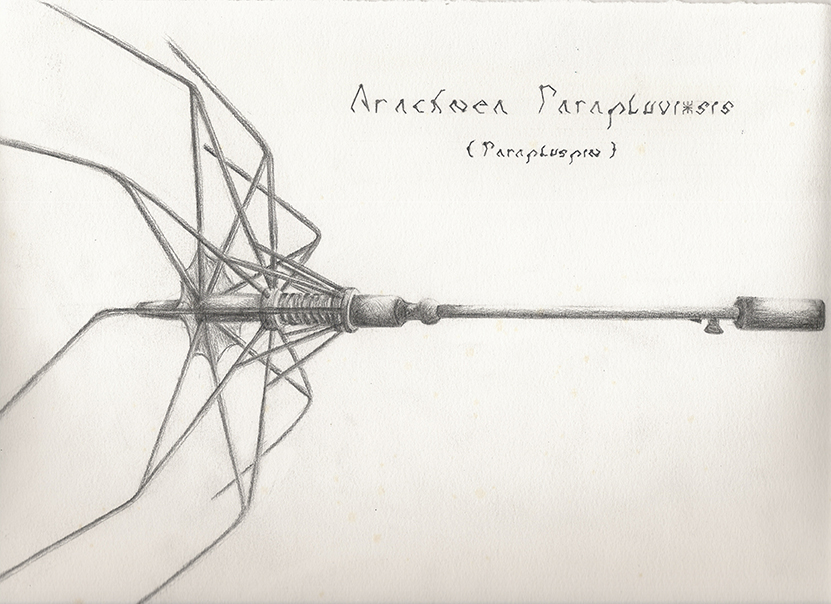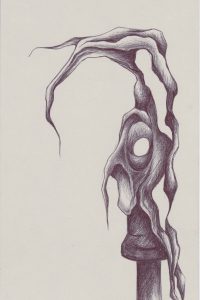Arachnea prappluviosis, also known as the umbrella spider, is a fascinating phylum of the animal kingdom -unless this is a taxonomical underestimation and they constitute a kingdom of their own. The diversity of species also includes a wealth of unique behavior types, specific living conditions, and exceptional biotopes. This page delves into the scientific knowledge already available on their lifestyle and where further progress can be made. As the study of the umbrella spider is still in its infancy, the page will be supplemented and updated as necessary.
Arachnea parapluviosis in Natural Philosophy
Etymology
The name Arachnea parapluviosis likely derives etymologically from a questionable translation of the Dutch term parapluspin into a mixture of Dog Latin and -Greek. In French, the name is araignée parapluique, in English umbrella spider, in Italian ragno di ombrello, and in German Regenschirmwebspinne, usually abbreviated to Schirmspinne. Arachnea parapluviosis should not be confused with the Theridiosomatidae family, also referred to as umbrella spiders in Dutch. The scientific names of the respective species are often also hybrid forms of Latin and/or Greek.
The naming reflects the clumsy way in which Arachnea parapluviosis was initially discovered. In the early days, his doctorship von Leverkühn did not differentiate between Parapluvids and Parasolids treating both as mere variations of the same species. So it could happen that one species was named Arachnea parapluviosis louisiensis, although it clearly belonged to the Parasolids and should have been named Arachnea parasolis louisiensis.
Taxonomy
The taxonomy of Arachnea parapluviosis remains a subject of heated debate and has a turbulent history. Initially, his doctorship von Leverkühn assumed it to be a species within the order of Araneae, the spiders. However, the discovery of more species soon led him to conclude that he was dealing with an entirely new phylum.
The umbrella spider phylum is divided into four orders : Parapluvids, Parasolids, Papyrids and the most recent addition : the triDeïds. Since his doctorship von Leverkühn lacks modern equipment for DNA analysis, distinctions among these orders are primarily based on external features and body structures. This limitation prevents clear boundaries between the orders. For instance both Parasolids and Parapluvids include species that utilize bioluminescence, although it remains unclear whether this is a case of convergent evolution, hybridization or even interspecies sexual relations.
There is also the growing doubt about whether or not the status of phylum is fitting. Given their unique blend of animal, plant, fungal, bacterial, and even viral traits, there is serious speculation that they may constitute an entirely new kingdom.

Evolution
Due to a lack of fossils, the origins of the umbrella spider are shrouded in mystery. Arachnea parapluviosis saxifraga, the stonebreaker, could be dated back a few hundred years, given the supposed number of generations required to adapt to the lime-rich walls of Ypres. Of course this assumes the stonebreaker -and all the other species of Arachnea parapluviosis– evolved naturally and wasn’t the result of an experiment.
Two hypotheses suggest the latter. According to the first, Arachnea parapluviosis megaviralis may be the original umbrella spider. While his doctorship von Leverkühn insists he is the spider’s discoverer, not its creator, 1950s photos suggest megaviralis once hid in the Bacteriological Institute of Leuven. According to the second hypothesis Arachnea parapluviosis descends from two maritime ancestors : Arachnea parapluviosis crinoidea and Arachnea parapluviosis triDrinoïdea. Both species may have been a human-engineered symbiosis of crinoids and metal-dissolving bacteria, created with the noble intention of bioremediation by filter metallic particles from the world’s oceans.
Life and Death of Arachnea parapluviosis.
Distribution & Habitat
Observations of Arachnea parapluviosis are limited to the Low Countries, especially the provinces of West- and East-Flanders, Antwerp and Flemish Brabant. A rumoured umbrella spider tree allegedly appeared on the wall of an Irish cultural institution but quickly died due to the sterile, spider-hostile environment. Having to admit that one is not a healthy environment is not a pleasant task for a cultural institution, so it is not surprising that they prefer to keep this a secret.


Morphology & Physiology
The exoskeleton of an umbrella spider closely resembles a bare umbrella frame. Its characteristic parts include the rib-like legs and a stem-like protrusion ending in a bulb that houses essential bodily functions. The exoskeleton is composed of materials rarely found in other life forms, with high concentrations of metals and plastics.
Behavior
There are some exceptions, mostly belonging to the genus Anelosimus, but spiders are predominantly solitary animals. Umbrella spiders, on the other hand, show a high degree of social behavior. In human-controlled environments, they rarely survive on their own, as they are quickly seen as pest and consequently disposed of. It is not uncommon for such a lonely umbrella spider to meet a sad end in a garbage can.
His doctorship von Leverkühn observed intriguing social behaviours in the Papyrids order. Similar to social amoebas like Dictyostelium discoideum and the social myxobacteria, they form a tree-like structure under deteriorating conditions. The crown does not form spores as in the amoebas and bacteria, but is carried away by wind and water in search of better conditions, while the stem and its constituent spiders die.
This behavior has not been observed in Parasolids or Parapluvids (yet) but is hotly debated in psychoanalytic circles and causes division between those who finally see in the phenomenon a symbol of the penis clavatus, the pinned penis, and those who are firmly convinced that there is no male counterpart to the vagina dentata, especially not when it would be composed of distinctly female symbols.

Diet
If Arachnea parapluviosis crinoidea was the progenitor of all umbrella spiders, they may all have started as metal-eating creatures before some of them evolved into other, divergent diets. Some, like Arachnea parapluviosis aquaphosphorescensis, now consume various pollutants in water, while the stonebreaker feeds on limestone. Arachnea parapluviosis mixtrunca has adapted to a wood-based diet.
Reproduction & Development
The reproductive behavior of Arachnea parapluviosis is the subject of wild speculation. Some observations may suggest that they are the last remaining example of generatio spontanea, spontaneously rising from the abandoned, lifeless remains of broken umbrellas. However, other observations point much more toward a viral reproductive strategy, in which the swollen upper part of the spider’s body is an example of bizarre sexual selection and simultaneously a formidable weapon and fearsome sex organ.
The species of Arachnea parapluviosis are, uniquely in nature, composed solely of male individuals. During dissection, no oocytes have ever been found, only male gametes.
Umbrella spiders engage in a gruesome mating ritual, in which two individuals first attempt to impress each other with their erected knob at the top of the stalk. The protrusions and cavities formed in the process perform an elaborate dance. Often, this is enough to determine dominance Oother times, it escalates into physical confrontation, with the protrusions taking on a hooked form. As in stoneflies the hooks are used to restrain the partner. The dominant individual ultimately succeeds in inserting his sperm cells, although cases have also been documented in which both partners transfer spermatozoa to each other. For the receiving individual, this is a life-threatening catastrophe. The gametes of the dominant partner fuse with the gametes of the recipient, but since both are male and lack sufficient nutritional reserves, they attach to the host’s body cells and begin to digest them. A fertilized umbrella spider has only a limited window of time to rid its body of the parasitic cells and must, in that period, seek out a suitable host organism. According to various urban legends, one of their preferred targets is the human being.
Het voortplantingsgedrag van de Arachnea parapluviosis lijkt sterk op dat van virussen en is dan ook een ondersteuning voor de hypothese van Arachnea parapluviosis megaviralis als stamvader.
The reproductive behavior of Arachnea parapluviosis strongly resembles that of viruses and thus supports the hypothesis of Arachnea parapluviosis megaviralis as the progenitor. It may also partly explain the social behavior of umbrella spiders. Through cooperation, they can hunt for a host in groups, increasing their chances of timely disposal of their fertilized cells. In that case, the mating behavior could even be interpreted as a purely aesthetic display rather than aggression-based.

Fecalization
As social animals, umbrella spiders have their own complex language. Due to its fascinating nature and the shear amount of time his doctorship von Leverkühn spent on fecalization, a separate page is dedicated to exploring their linguistic behavior.
Enemies
Most species of Arachnea parapluviosis appear to have no natural enemies. Given their likely short evolutionary history, this is not entirely surprising — as with many invasive species, the environment they have entered has not yet adapted to their presence. However, they do seem susceptible to disease, and the materials from which they are composed are prone to various forms of corrosion.
The only clearly demonstrable enemies of the umbrella spider are human beings.
This antagonism can be both active and passive. Arachnea parapluviosis louisiensis, for instance, was eradicated -presumably on the orders of the Belgian cultural elite. Conversely, human intervention in other areas can also have disastrous consequences : Arachnea parapluviosis aquaphosphorescensis disappeared in a short time due to a sudden increase in light pollution combined with a significant decrease in water pollution.

Arachnea parapluviosis in Culture and Lore.
References to Arachnea parapluviosis are rare in mythology and literature. Only Franquin mentions it briefly in Gaston Lagaffe, album 12, gag 661. Considering the umbrella spider’s resemblance to the popular utensil , it would be surprising if no one else noticed it.
In future Urban Legends
His doctorship von Leverkühn is convinced that within a few decades there will be countless urban legends about the umbrella spider. One of the most popular, according to him, has to do with the umbrella spider’s reproductive strategy. Somewhere in the distant future he will be invited by an unnamed city to clean up the metal pollution there. The townspeople will be happy to see him come with his spiders, but after the clean-up they refuse to pay the agreed price. This happens again and again. Like a futuristic Pied Piper of Hamelin his doctorship von Leverkühn decides to tinker with the reproductive system of his umbrella spiders and make humans the most beloved host species. The fate of parasitized humans is not enviable, they are eaten from the inside out and ultimately die a horrible death.
In Sciences
The scientific community has -to say the least- an ambiguous relationship with Arachnea parapluviosis. The Wikipedia controversies are detailed on a separate page, along with its impact on psychoanalysis. Its impact on linguistic is explained on the page dedicated to fecalizations.









